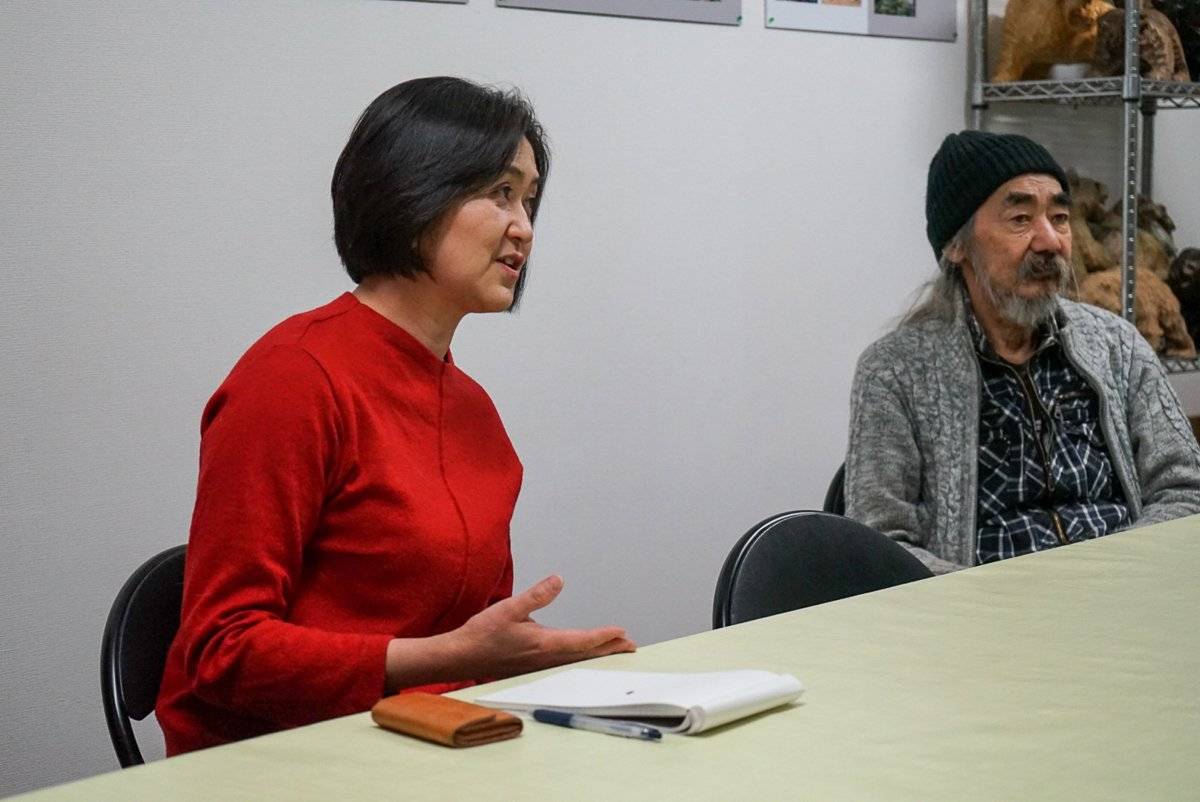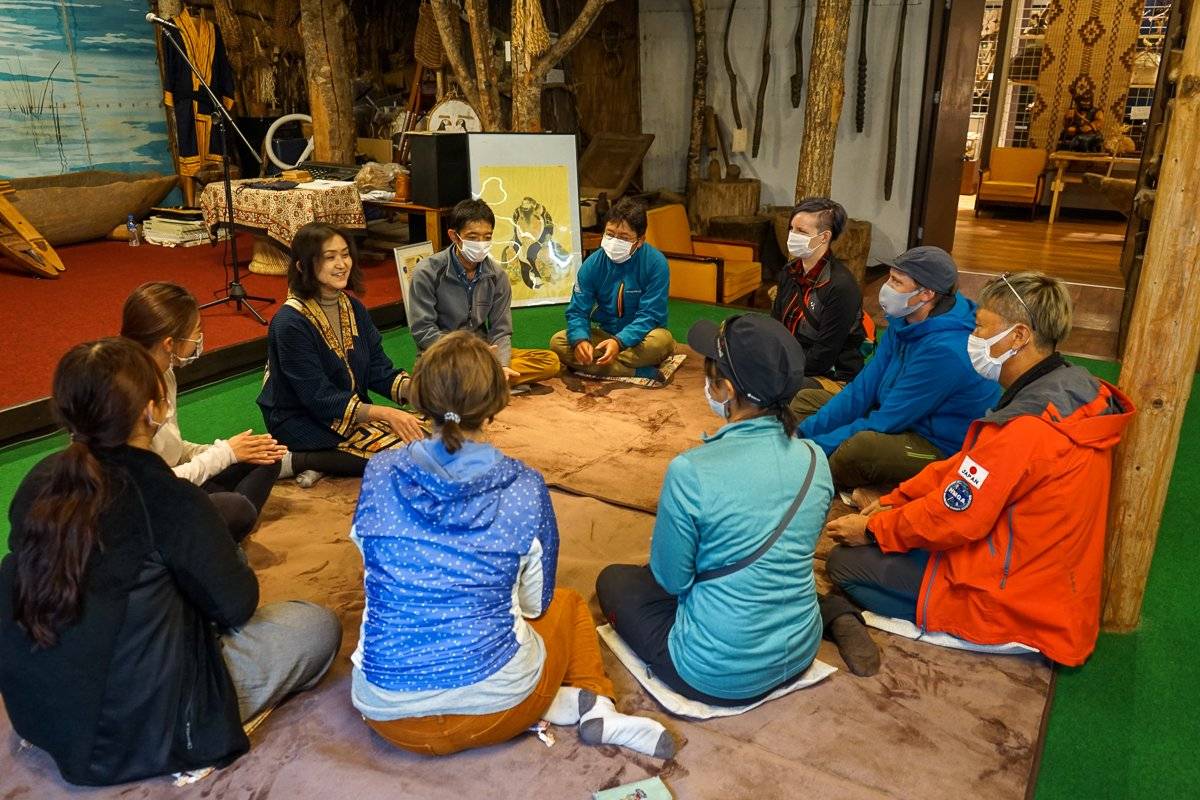In this article, we would like to share a thought-provoking discussion we had with Shinrit Eoripak Aynu (Kenichi) and Hisae Kawamura about Ainu indigenous cultural tourism.
Ainu Indigenous Cultural Tourism
Our Culture
By Ayaka

Hokkaido is home to the Ainu or Aynu, Indigenous people of Japan. On our tours, we often talk about them and where possible we try to fit in a visit to an Ainu museum in our itineraries. The Ainu are an integral part of what shapes Hokkaido, and cannot be left out of discussions about Hokkaido’s history and culture.
As we take guests to these places of cultural and historical significance to the Ainu, we’ve also come to increasingly question ourselves: “How do the Ainu perceive tourism and tourists?” “Is conventional Ainu tourism ethical?” To obtain answers to these questions, we visited and interviewed the Directors of Kawamura Kaneto Ainu Museum in Asahikawa.

First of all, who are the Ainu? Where do they come from?
[Hisae] The Ainu are the indigenous people of Hokkaido. Our ancestors are thought to have arrived in the Archipelago of Japan via a few different routes from Eurasia during the ice age between 35,000 and 8,000 years ago. The Ainu are the offspring of the people who reached Hokkaido and settled on the island to date.
[Kenichi] The others who didn’t end up in Hokkaido went as far as Russia and the United States. There is a tribe that resides near the Amur River, and they have close ties with the Ainu. We could say that the Native Americans are our distant relatives.
[Hisae] While Ainu culture today is distinct from Japanese culture, the Ainu ethnicity was developed over time while maintaining close ties with the Jomon People, who were living in Japan. It is likely that the Ainu and the Jomon shared a common language. There is some evidence that they traded goods and animals. The Ainu are people who inherited Jomon’s genetic and anthropological features the most.

How many Ainu are still around?
[Kenichi] There are approximately 13,000 Ainu. This is the official number. But it is said that there are 85,000 more. They are the so-called Silent Ainu. Including second and third generations, the total population could be more than 100,000. They hide their identity for fear of discrimination which sadly still occurs. As of August 5th 2019, the New Ainu Law* was enacted and the National Ainu Museum will be opening next month. (May 2020 at the time of interview) Despite these movements, we cannot completely eliminate discrimination from society, unfortunately.
*For the first time in the Japan history of law, the Ainu were acknowledged as the indigenous people
[Hisae] Of course, a survey is conducted every five years. Questionnaire forms are distributed, which contain such questions as, “How did you find out that you are of Ainu descent?” and “Do you suffer from discrimination?” Local authorities are in charge of distributing these forms to the household that they know Ainu reside in. Therefore their scope of survey is limited to those families who cooperate with such surveys (who are already identified as Ainu, and who don’t mind answering those questions).

[Kenichi] I am half Ainu and half Japanese. My father is Ainu and my mother is Japanese. My mother was adopted into an Ainu family, as their parents were colonizers from Honshu and failed in their mission to cultivate their land. There were about 5,000 Japanese children adopted by Ainu families then. Among them, there were often infants abandoned and left in a basket in front of Ainu houses. Culturally, Ainu cherish children so most of them were accepted.
[Hisae] Identifying one as “half” is determined by genealogy. It may be important in Japanese culture, but it may not be so in Ainu culture. There may be people who have Ainu blood, but they don’t know about it. We don’t know the exact numbers, but we know for sure that there are at least 13,000 Ainu living today. The problem is that we ourselves are not given right to define “Ainu”. We do not have a definition clearly set like other counties that have an indigenous population.
How did Ainu indigenous cultural tourism begin in Hokkaido?
[Hisae] Around 50 to 60 years ago, there was a boom in tourism. At that time, people were interested in experiencing more unusual tourist attractions and experiences. Some Ainu became wealthy and influential, and they were able to do things in their own way. On the other hand, with such tourism cultural traditions can be conveyed in a somewhat distorted way. So we can’t say what is right and what is wrong. The ideal will be that we feel proud of our culture and then let tourists experience it while building their understanding in an enjoyable way. Hokkaido hasn’t reached that stage yet. It is quite difficult for Ainu individuals to dive right into the tourism business.

How do you feel about Ainu tourism going forward?
[Hisae] Firstly, tourists, guides, operators and ourselves all have to stand in fair positions. We have to study, ourselves included, to prepare to receive tourists well. We would like to find a more integrated way of mutually learning and working together. For example, we no longer go into the mountains as frequently now and don’t necessarily know where to find certain kinds of trees or plants, but nature guides may know where to find them. In this way, we can share our knowledge about how Ainu used to use and relate to those natural resources in their daily lives. No matter our nationality, we want to stand on equal ground.

Visit Kawamura Kaneto Ainu Museum
If you have some time during your visit to Hokkaido, we highly recommend a visit to the Kawamura Kaneto Ainu Museum. They are welcoming and open-heartedly share their knowledge and thoughts about Ainu history, culture and where they stand today. Pop in to their museum (it’s also where they live) and say “irankarapte“, hi in the Ainu language!

- Open Hours – Everyday from 9:00 am to 5:00 pm (From July to August from 9:00 am to 6:00 pm)
- Entry Fee – ¥500